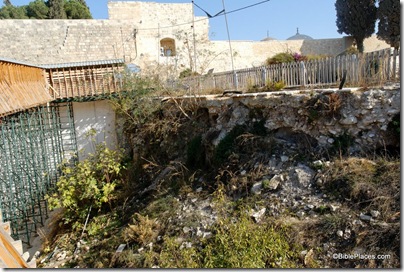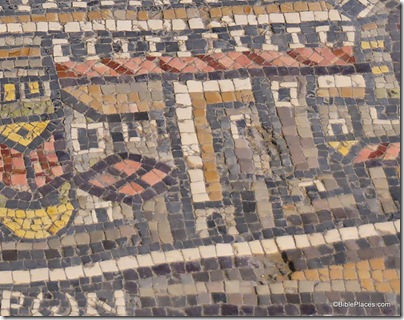This post relates more to blogging than to biblical sites, but it may be of interest to fellow bloggers and those curious about some of the issues we face. A couple of days ago I received an email informing me that this blog had been named “a top 50 biblical history blog” by “A Blog of Biblical Proportions.” I’ve seen a handful of similar emails over the last year and they always struck me as a bit strange. For one, the name of the domain is unrelated and sounds commercial, such as accreditedonlinebiblecolleges.org. For another, when I look at the “Blog of Biblical Proportions,” I see that the blog posts are sporadic (none since November) and there is no consistent theme (other posts are “25 Excellent iPhone Apps for Bible Study” and “Top 50 Blogs for Online Scripture Study”). Each of these posts consists of annotated listings of blogs or websites. That’s nice, but why? Who is creating this and what is their motivation? I don’t see any Google ads or other obvious advertising which would suggest a profit motive. Another observation is that this site (and ones similar) is pseudo-anonymous. By that I mean that they have names associated with them, but they are only first names and they seem generic (Linda, Miranda, James). There is nothing else on the website that gives any background about the writer(s). Bloggers don’t necessarily put their address online, but they have some kind of identity. It’s clear to me that something is fishy, but I just can’t put my finger on it. Last week, I received an email suggesting that my readers would enjoy the new post at the “Biblical Learning Blog” (notice the goofy name again) on 25 Open Courseware Classes about Early Christianity. The post listed a few good options for study (but not related to “Early Christianity”) and I included the link on the Weekend Roundup, though I was still not sure what was going on. I think I understand now how the operation works. Some entrepreneur (probably a single individual with multiple pseudonyms) wants to earn a few bucks and he knows he can do that through a service that pays you if you collect address details for prospective college students. I don’t know what this pays, and apart from what I’ve deduced, I didn’t know that colleges paid for address lists. But that clearly seems to be going on at this website with their links to nine different schools at the bottom of this page. None of the links go directly to the colleges, but all are directed through a third-party site, which suggests that this is not someone primarily concerned with getting you information about the school. How does this tie in to the “top 50 biblical history blogs”? In order to make money, the site needs visitors interested in going to college. The best way to get visitors is from Google (though BiblePlaces.com is linked from thousands of websites, more visitors come from Google searches than from the rest combined). The key to getting visitors from Google is to be highly ranked. If a prospective college student searches for “online bible college,” he probably will never click on your site unless it is ranked in the top three. Securing a high rank for the website is a challenge. Many, many “entrepreneurs” have tried various methods for years to trick Google into thinking a purely commercial portal is actually a worthy site with content. Google learns their tricks, and so new methods evolve. The current method appears to combine a commercial portal with some “genuine content.” So in our example, a list of top blogs or best courseware is written. It doesn’t take that much time to create such a list (a few hours with Google), especially when the “annotations” reflect nothing more than a brief visit. For instance, the annotation on the “top 50” list for this blog simply copies what is given in the blog description (professor in Israel…). I wouldn’t say that that is not helpful, but it is fast and easy and could be written by absolutely anyone. Google likes it that the site has “real content.” But what is even more necessary are incoming links. Google isn’t a person and it doesn’t evaluate each website individually. Rather it lets other humans do its work. If lots of humans are adding links from their websites/blogs to a particular site, then Google thinks that people must value it and its ranking goes up. The old way to get links to your site was by “link exchanges,” but these are basically dead now. I get a couple of requests a week, asking me to add a link to a website such as “Real Estate in Cyprus” and in return they’ll add a link to BiblePlaces.com. The problem with this is that the requests are rarely to websites of interest or value to my readers. Even if they were, I have no idea if the company is honorable or not. So how does the commercial website get links when reputable websites won’t link to them? One strategy apparently is to post “top 50” lists. The entrepreneur then emails everyone who has been “named a top 50 blog” with the comment that “I thought you and your readers at Bible Places might be interested in taking a look.” The blogger is “honored” and when he mentions his ranking on his blog, he links back to the “top 50.” A link exchange has just occurred. The “top 50” websites/blogs may not be the most popular websites, but they have a real author and real readers and they have just made the “online bible college” website more worthy in Google’s eyes. Furthermore, given that many of these websites are blogs, the links last forever. Years ago, many websites had lists of links which were occasionally revised. If the website owner got wise to the fact that a certain site was never updated and appeared to be a front, he would delete the link. But bloggers are very unlikely to dig back through previous posts to check and remove links. Even if no one ever goes back to read the old posts, the links still exist in Google’s index. The approach is rather ingenious. The website has one goal (earn commissions from college recruits), but it achieves its goal primarily through the creation of unrelated content. Bloggers are flattered by the “honor” and may not realize that the list was created by someone without any interest in or knowledge of their discipline. As I said at the beginning, this discussion is only tangentially related to “Bible Places,” but it may be helpful to a few bloggers who don’t realize what is going on. I don’t want to criticize websites or blogs that make money through advertising or sales (this one does), but knowing that things are not exactly as they seem makes me less likely to link to these sites in the future.
Archaeologists revealed today that they have discovered portions of the main east-west street in Jerusalem during the Byzantine period. Known in Latin as the Decumanus, this main thoroughfare went from the area of today’s Jaffa Gate to the center of the city. Archaeologists uncovered large sections of the Cardo, Jerusalem’s north-south street, in the 1970s, but this is the first time that the Decumanus has been identified.
The Decumanus is depicted on the Medeba Map, a mosaic depiction of the land of Israel dating to A.D. 580. (See yesterday’s post for a photo.) According to the map, the Decumanus was neither as wide nor as long as the Cardo. The Byzantine-period street was discovered 13 feet (4.5 m) below present ground level and was paved with large flagstones.
The discovery was made during renovation work on the street running through Jaffa Gate (see area photograph here). Because of the high traffic volume, excavations have never been carried out in this area.
For more information, see the press release of the Israel Antiquities Authority (temporary link). Four high-resolution photos are also available(direct link here): (1) a view of the area of the street, taken on Feb 7; (2) a close-up view of the flagstones; (3) a large cistern discovered underneath the street; (4) the Medeba Map, with the Decumanus outlined in red. Haaretz has a brief article, and the other news outlets will have stories posted later in the day.
- Tagged Discoveries, Excavations, Jerusalem
In the center of this photo is pictured the area of Jaffa Gate, as depicted on the 6th century mosaic map discovered in Medeba, Jordan. Recent discoveries in Jerusalem reportedly “confirm an ancient map of Jerusalem.” Tomorrow morning a press conference will be held at Jaffa Gate. Until then, you can try to guess what they found. I have my own prediction.
- Tagged Discoveries, Jerusalem
The collapsed ramp that leads to the Mughrabi Gate of the Temple Mount appears to be no closer to reconstruction. From Arutz-7:
Jordanian pressure is preventing the completion of a walkway to the Temple Mount next to the Western Wall (Kotel), according to Nadav Shragai, senior researcher at the Jerusalem Center for Public Affairs. The Islamic Historical Society has filed suit in the Jerusalem District Court, demanding a halt to the work on widening the Kotel Plaza and the renovation of the Rambam (Mughrabim) Gate entrance to the Temple Mount. The court is awaiting a reply from the Prime Minister’s Office on the matter. […] The plan for renovating the walkway to the Rambam Gate has been approved, Shragai said, but the government is delaying its implementation. “At first they wanted the bridge to be suspended from support columns,” the veteran former journalist explained, “but environmental groups objected. In the end it was decided that the bridge would be placed on what remains of the [dirt] ramp, in order to avoid damage to houses in the Mughrabim neighborhood. This plan currently has the necessary approvals and all that is needed is a construction permit from the Kotel Heritage Fund which answers to the Prime Minister’s Office. For some reason, because of pressure from the Jordanian government, the government is not granting this permit.”
The full story is here.  Collapsed ramp (center) and temporary wooden ramp (left). The Mughrabi Gate is just visible at the end of the temporary ramp.
Collapsed ramp (center) and temporary wooden ramp (left). The Mughrabi Gate is just visible at the end of the temporary ramp.
- Tagged Jerusalem, Temple Mount
Five hikers were wounded when a mine exploded near Mount Avital in the Golan Heights.
Richard S. Hess has written an essay on the “Names in Genesis 11” at The Bible and Interpretation.
Professor Donald Wiseman passed away this week.
You can see and read more about the 1st century boat found at the Sea of Galilee at the new website entitled the “Jesus Boat Museum.” I can’t say I like the name they’ve chosen for marketing purposes, but they have some good photographs and explanations about an important archaeological discovery.
The Biblical Learning Blog has a post about “25 Open Courseware Classes about Early Christianity.” The title is a bit misleading, but you may find some subjects of interest here, including a Notre Dame course on Ancient Rome, a MIT course on Ancient Greece, or a Boise State course on the Crusades.
- Tagged Galilee, Resources, Weekend Roundup
The BiblePlaces Blog provides updates and analysis of the latest in biblical archaeology, history, and geography. Unless otherwise noted, the posts are written by Todd Bolen, PhD, Professor of Biblical Studies at The Master’s University.
As an Amazon Associate we earn from qualifying purchases. In any case, we will provide honest advice.



